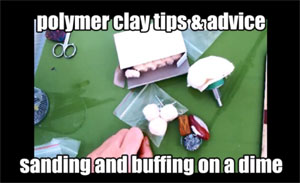A lot of times I am getting asked "do I NEED to sand my pieces?"
Well, the answer can be yes and now. It all depends on what kind of surface technique you have used for your piece. If you have used any kind of mica powders or any other type of covering, like acrylic paint, metallic waxes, etc. of course, you definitely should NOT sand - sanding will remove your effects.
But if you used a normal veneer or any other type of surface that doesn't have anything applied to it, then yes.
The other question is "I am going to apply varnish/glaze/resin anyway, why do I need to sand?"
Well, because even varnishes or glazes or even resin, do not look as good on rough polymer clay as they do on sanded polymer clay. Certain effects - like the mica shift based ones, for example - don't show their full beauty until they are sanded.
As a side note, did you know that the mica shift technique was initially achieved by sanding the clay, not by shaving it?
So yes, you pretty much must sand. That is, if you want to have beautiful results.
Now, the question, how do you sand? There are mandatory things to consider.
1. Always use the sandpaper type that can be used with water. You do not want to dry-sand polymer clay. The resulting dust is very fine and very damaging to your lungs if inhaled. Honestly, I use a mask even when I wet-sand.
2. Go gradually with increasing grits. Start with a 350-400, then go up increasing about 200-250 grit numbers. Like 400-600-800-1000. How high can you go? It's up to you, I personally go most of the time 2000 or 2500, but sometimes I may go as high as 3000 or 3500. It depends a lot on what you intend to do. If your intention is to varnish/glaze, 1000 and even 800 is enough. If you want to buff, the higher the grit you get to, the higher the gloss of your buff.
As for the point 2. Does it matter if you skip to a higher grit? Like from a 400 to a 2000? Again, it depends. Mostly on the polymer clay brand you've used. Some polymer clays get faster sanded than others. On most Premo, for example, the 2000 will definitely remove the scratches a 400 grits leaves on your clay. On Pardo though, it won't. Pardo is tougher so it needs a gradual sanding. Otherwise, if you go to a grit that is too high, it will not be able to remove those marks left by a lower grit sandpaper. It affects the look.
I personally use sanding sponges for the lower grits, as they are easier to grip, then anything higher than 400 is either sandpaper or the Poly-fast.
You can get higher grits of sandpaper either in the craft stores, or, better, in the auto-stores. Look in the automotive paint finishing isle. A lot of times you can even find there kits, with grits going from 400 to 2000.
Here's a small tutorial on how to sand (and buff) without spending a lot.


